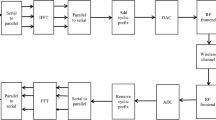Abstract
This paper presents a digital implementation of a Multi-Carrier Modulation scheme without spectral overlapping between sub-carriers. This scheme uses aQAM modulation and a square root Nyquist pulse shaping function. It guarantees orthogonality between sub-carrier signals even after transmission over a dispersive fading channel. The modulator and the demodulator use aK-pointDFT and a set of polyphase filters. Therefore all single-carrier equalization and detection techniques can be used in this Multi-Carrier Modulation system.
Similar content being viewed by others
References
B. Hirosaki, “An orthogonally multiplexed QAM system using the discrete Fourier transform,” IEEE Trans. Comm., Vol. COM-29, No. 7, 1981.
B. Hirosaki, “An analysis of automatic equalizers for orthogonally multiplexed QAM systems,” IEEE Trans. Comm., Vol. COM-28, No. 1, pp. 73–83, 1980.
S.B. Weinstein and P.M. Ebert, “Data transmission by frequency division multiplexing using the discrete Fourier transform,” IEEE Trans. Comm., Vol. COM-19, pp. 628–634, 1971.
L.J. Cimini, “Analysis and simulation of a digital mobile channel using orthogonal frequency division multiplexing,” IEEE Trans. Comm., Vol. COM-33, No. 7, pp. 665–675, 1985.
I. Kalet, “The multi-tone channel,” IEEE Trans. Comm., Vol. COM-37, No. 2, pp. 119–124, 1989.
M. Alard and R. Lassale, “Principles of modulation and channel coding for digital broadcasting for mobile receivers,” EBU Review -Technical, No. 224, pp. 168–190, 1987.
N.J. Fliege, “Orthogonal multiple carrier data transmission,” European Trans. on Telecomm. and Related Technologies, pp. 255–263, 1992.
S. Stein “Fading channel issues in system engineering,” IEEE Journal on Selected Areas in Communications, Vol. SAC-5, No. 2, 1987.
J.G. Proakis, Digital Communications, New York, McGraw-Hill, 1989.
A. Chini, Multi Carrier Modulation in Frequency Selective Fading Channels, Ottawa Carlton Institute for Electrical Engineering, 1994.
H. R. Vallet, Multi-Rate Digital Signal Processing for Communications, Cost, 1990.
R. Haas, “Multiple carrier transmission with time-frequency well-localized impulses,” Proceedings IEEE Second Symposium on Communications and Vehicular Technology in the Benelux, pp. 187–193, 1994.
R.E. Crochiere and L.R. Rabiner, Multi-Rate Digital Signal Processing, Englewood Cliffs, New Jersey, Prentice-Hall, Inc., 1983.
M. Mouly and B. Pautet, The GSM System, edited by the authors in 1993.
Author information
Authors and Affiliations
Additional information
This work was supported by the Centre National d'Études des Télécommunications (FRANCE TELECON) under Contract No. PE 7224.
Rights and permissions
About this article
Cite this article
Vallet, R., Taieb, K.H. Fraction spaced Multi-Carrier modulation. Wireless Pers Commun 2, 97–103 (1995). https://doi.org/10.1007/BF01099532
Issue Date:
DOI: https://doi.org/10.1007/BF01099532




